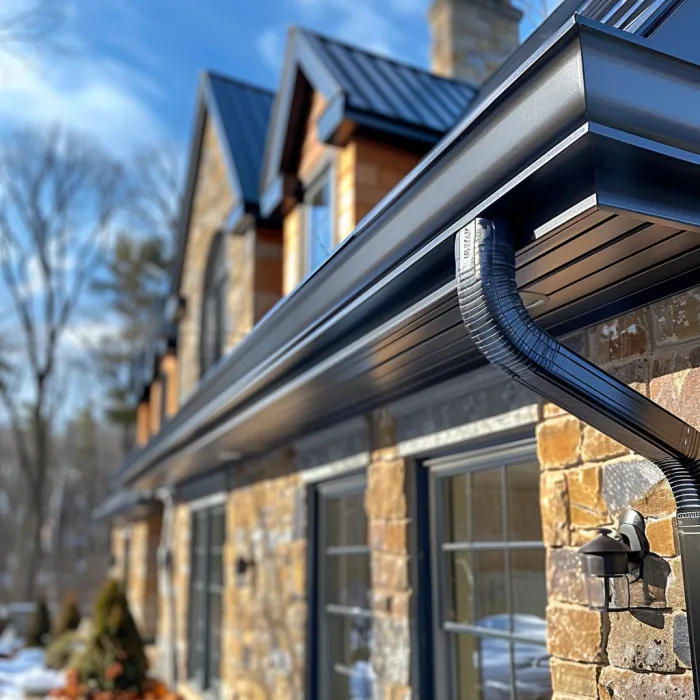
Understanding Eavestroughs: Essential Guide for Homeowners
Table of Contents
- What is an Eavestrough?
- Why Do Homes Need Eavestroughs?
- The Different Types of Eavestroughs
- How to Install Eavestroughs
- Common Installation Challenges
- Maintaining Your Eavestroughs
- Tips for Easy Maintenance
- Conclusion
- FAQs About Eavestroughs
Eavestroughs, also known as gutters, are an essential component of your home’s roofing system. They play a crucial role in collecting rainwater from the roof and directing it away from your house, helping to keep your home safe and dry. To learn more about the importance of eavestroughs and how to maintain them, visit 401 Siding on Google Maps, your trusted experts in eavestrough installation and maintenance.
What is an Eavestrough?
An eavestrough, commonly called a gutter, is a crucial part of your home’s roofing system. It collects rainwater from the roof and directs it away from your house. This is important because it helps keep your home safe and dry.
Why Do Homes Need Eavestroughs?
Eavestroughs play a vital role in protecting your home from various water-related issues:
- Preventing Water Damage: By directing water away, eavestroughs prevent water from pooling around your home, which can lead to costly damage.
- Reducing Soil Erosion: Eavestroughs help prevent soil erosion around the foundation of your home, maintaining the landscaping and foundation integrity.
- Avoiding Basement Flooding: By managing how rainwater flows around your home, eavestroughs help prevent basement flooding.
- Protecting Siding and Windows: They help keep siding and windows free from water damage and leaks.
The Different Types of Eavestroughs
There are several types of eavestroughs, each made from different materials:
- Aluminum: Lightweight and rust-resistant, popular for its durability.
- Vinyl: Economical and easy to install, resistant to rust and corrosion.
- Steel: Very strong and durable, ideal for harsh climates.
- Copper: Highly durable and aesthetically appealing but more expensive.
How to Install Eavestroughs
Installing eavestroughs involves a few key steps:
- Measuring Your Roof: You need to know how much material to buy.
- Choosing the Right Type: Pick the material that suits your climate and budget.
- Preparing the Roof Edge: Ensure that the edge of your roof is ready for installation.
- Securing Eavestroughs: Attach the eavestroughs securely to your roof with brackets.
- Connecting Downspouts: Attach downspouts that will carry the water to the ground.
For professional eavestrough installation services, contact the experts at 401 Siding today.
Common Installation Challenges
- Improper Slope: Eavestroughs must be installed with a slight slope to ensure water flows towards downspouts.
- Misaligned Sections: Sections must align perfectly to prevent leaks.
- Inadequate Sealing: Joints and seams need to be sealed properly to prevent water from leaking.
Maintaining Your Eavestroughs
To keep your eavestroughs working properly, regular maintenance is crucial:
- Regular Cleaning: Remove leaves and debris to prevent clogging.
- Inspect for Damage: Look for signs of wear and tear and fix them promptly.
- Ensure Proper Flow: Check that water flows freely and doesn’t pool in spots.
Tips for Easy Maintenance
- Use Guards: Gutter guards can help keep debris out of your eavestroughs.
- Schedule Inspections: Check your eavestroughs each spring and fall.
- Hire Professionals: If you’re not comfortable doing maintenance yourself, consider hiring professionals.
Conclusion
Eavestroughs are a key element of your home that need regular attention to function properly. By understanding their importance, how to install them correctly, and how to maintain them, you can protect your home from many potential issues. If you haven’t checked your eavestroughs lately, now might be a good time to take a look and make sure they are in good condition. For all your eavestrough needs, trust the professionals at 401 Siding.
FAQs About Eavestroughs
How often should I clean my eavestroughs?
It’s good practice to clean them twice a year—once in the spring and once in the fall.
Can I install eavestroughs myself?
Yes, if you are handy and have the right tools, you can install eavestroughs yourself. However, for best results, professional installation is recommended.
What should I do if my eavestroughs are leaking?
Check for and seal any leaks. If leaks are widespread, it might be time to replace your eavestroughs.
How long do eavestroughs last?
Depending on the material and maintenance, eavestroughs can last from 20 to 50 years.
What is the best material for eavestroughs?
Aluminum is popular due to its cost-effectiveness and durability, but the best material can vary based on your budget and climate.
Are gutter guards worth installing?
Yes, gutter guards can significantly reduce the amount of debris that collects in your eavestroughs, reducing maintenance needs.
